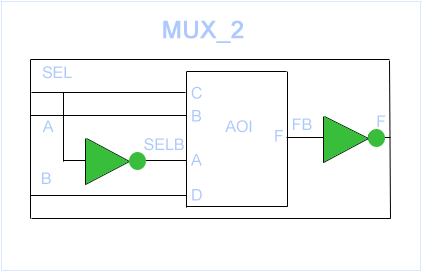Modules can reference other modules to form a hierarchy. Here we see a 2:1 multiplexer with an inverting data path consisting of an AOI gate and a pair of inverters.

Module Instances
The MUX_2 module contains references to each of the lower level modules and describes the interconnections between them. In Verilog jargon, a reference to a lower level module is called a module instance.
Each instance is an independent, concurrently active copy of a module. Each module instance consists of the name of the module being instanced (e.g. AOI or INV), an instance name (unique to that instance within the current module) and a port connection list.
The module port connections can be given in order (positional mapping), or the ports can be explicitly named as they are connected (named mapping). Named mapping is usually preferred for long connection lists as it makes errors less likely.
Verilog: 2-input multiplexer module
// Verilog code for 2-input multiplexer
module INV (input A, output F); // An inverter
assign F = ~A;
endmodule
module AOI (input A, B, C, D, output F);
assign F = ~((A & B) | (C & D));
endmodule
module MUX2 (input SEL, A, B, output F); // 2:1 multiplexer
// wires SELB and FB are implicit
// Module instances...
INV G1 (SEL, SELB);
AOI G2 (SELB, A, SEL, B, FB);
INV G3 (.A(FB), .F(F)); // Named mapping
endmodule
// end of Verilog code
Yes, it's time to dissect the code line by line again, but we'll concentrate on the new lines as the module interface has been covered before (see A Simple Design).
Implicit Wires
// wires SELB and FB are implicit
The wires used in continuous assignments MUST be declared. However, one-bit wires connecting component instances together do not need to be declared. Such wires are regarded as implicit wires. Note that implicit wires are only one bit wide, if a connection between two components is a bus, you must declare the bus as a wire.
Module Instances
AOI G2 (SELB, A, SEL, B, FB);
In a module instance, the ports defined in the module interface are connected to wires in the instantiating module through the use of port mapping. For the instance of AOI, the first wire in the port list is SELB. In the module header for the AOI gate, A is the first port in the port list, so SELB is connected to A. The second port in the module header is B, the second wire in the port list is A, thus the wire A in MUX2 is connected to the port B of the AOI gate instance.
INV G3 (.A(FB), .F(F));
The second INV instance, G3, uses named mapping rather than positional mapping. In the port list for the G3 instance, the wire FB is connected to the input port, A, of the INV instance. The period character is followed by the name of the module header port; in brackets following the formal port, the name of the wire is entered.
Prev Next



